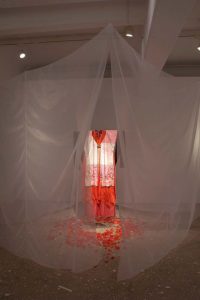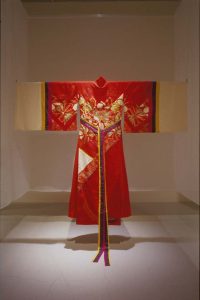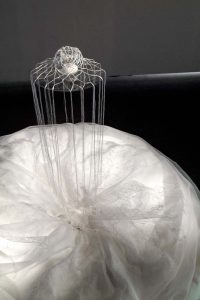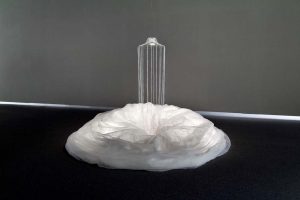Costume As A Second Skin

Scattered Flowers, 2005
Technique: Printing i-kat, silk screen
Material: Silk, Used-Kimono fabric, Sa
Installation View, Poetic moment, Tokyo Wonder Site. Photo: Riichi Yamaguchi

Wedding Dress for Minority Race, 2000
Used-Kimono fabric, silk. Technique: Sewing machine-work
180 × 180cm
Installation View, Kyoto Art Center Photo: Seiji Yoyonaga

Flower Spot, 2007
Silk, pincushion, sewing needle, acrylic board, wire, bulb Technique: Embroidery, macram
150 × 150 × 180cm
Installation View: Young Artist Selective Exhibition, The Museum of Kyoto, Japan. Photo: Seiji Toyonaga

Flower Spot, 2007
Silk, pincushion, sewing needle, acrylic board, wire, bulb Technique: Embroidery, macram
150 × 150 × 180cm
Installation View: Young Artist Selective Exhibition, The Museum of Kyoto, Japan. Photo: Seiji Toyonaga

Inside of Her Skirt, 2006
Polyester organdie, ink, silk yarn, reel, mirror, bulb, photo
Silkscreen print
Installation View: Memory Installation at Voice gallery, Kyoto, Photo: Seiji Toyonaga
Haji Oh
1 Jan 2000 - 31 Dec 2008
2000 – 2008
Memory
The fragments spill down
A memory etched on each fragment
Nowhere to go,
Floating, sinking, again and again,
I scoop up the fragments with cupped hands
And again, they spill,
Again, they float and sink,
Over and over again.
As I look at chima chgori that my grandmother left, I feel as if she is here.
Many things were wrapped in her skirt.
I printed the design on the cloth, again and again,
Each print, another fragment of memory.
The soft, white train of the skirt
Spreads on the wooden floor, endlessly,
Here are her memories, that I cannot know.
Have they vanished, along with her body that exist no more?
No memory is certain,
But I imagine something was there,
For my grandmother and the women of her generation.
Wedding dress for minority race, is a Japanese Kimono recreated in the Korean Hanbok style to be worn at weddings. This dress was made by cutting, stitching and restyling a Japanese Kimono to create a dress. The undergarment worn beneath this dress is also red in colour and is made of the Japanese Kimono fabric called Nagajuban. Through this wedding dress, Oh explores what it means to belong to a “minority race,” the Zainichi Korean living in Japan.
Sange (Scatered Flowers), shows an organdy curtain dropping from the ceiling over a dress. The dress has a long silk undergarment that was dyed a deep red. On top of this is worn a jacket and a skirt. The jacket is woven from silk and the skirt is stylized from a Japanese Kimono undergarment, the Nagajuban. Underneath the organdy curtain, petals made from silk were placed surrounding the dress. On these petals are printed words from a Korean song in Katakana, an alphabet of Japanese syllables. The dress is displayed on a set with media installations such as a television screen which shows hands continuously working on loom.
